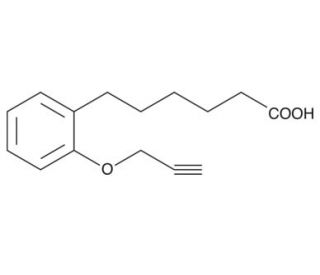

Molecular structure of PPOH, CAS Number: 206052-01-9
PPOH (CAS 206052-01-9)
Alternate Names:
6-(2-Propargyloxyphenyl)hexanoic acid
Application:
PPOH is an inhibitor of CYP epoxidase activity on arachadonic acid
CAS Number:
206052-01-9
Purity:
≥98%
Molecular Weight:
246.3
Molecular Formula:
C15H18O3
For Research Use Only. Not Intended for Diagnostic or Therapeutic Use.
* Refer to Certificate of Analysis for lot specific data.
QUICK LINKS
Ordering Information
Description
Technical Information
Safety Information
SDS & Certificate of Analysis
PPOH is a selective inhibitor of the epoxygenation reactions catalyzed by specific CYP450 isozymes. Arachidonic acid is converted by microsomal CYP450 enzymes to a variety of epoxides, ω-1 and ω-hydroxylated compounds via the epoxidase pathway.1,2,3 .4 PPOH inhibits the formation of arachidonate 11,12 epoxides by CYP4A2 and CYP4A3 enzymes with an IC50 of 9μM, but has effect on the formation of 20-HETE, the ω-hydroxylation product of CYP4A1.5
PPOH (CAS 206052-01-9) References
1 Capdevila, J.H., Karara, A., Waxman, D.J., et al. Cytochrome P-450 enzyme-specific control of the regio- and enantiofacial selectivity of the microsomal arachidonic acid epoxygenase. J Biol Chem 265 10865-10871 (1990). 2 Sacerdoti, D., Abraham, N.G., McGiff, J.C., et al. Renal cytochrome P-450-dependent metabolism of arachidonic acid in spontaneously hypertensive rats. Biochem Pharmacol 37 521-527 (1988). 3 Fitzpatrick, F.A., Murphy, R.C. Cytochrome P-450 metabolism of arachidonic acid: Formation and biological actions of "epoxygenase"-derived eicosanoids. Pharmacol Rev 40 229-241 (1989). 4 Imig, J.D., Falck, J.R., Inscho, E.W. Contribution of cytochrome P450 epoxygenase and hydroxylase pathways to afferent arteriolar autoregulatory responsiveness. Br J Pharmacol 127 1399-1405 (1999). 5 Wang, M., Brand-Schieber, E., Zand, B.A., et al. Cytochrome P450-derived arachidonic acid metabolism in the rat kidney: Characterization of selective inhibitors. J Pharmacol Exp Ther 284(3) 966-973 (1998).Inhibitor of:
CYP, and Enzyme.Ordering Information
| Product Name | Catalog # | UNIT | Price | Qty | FAVORITES | |
PPOH, 1 mg | sc-205442 | 1 mg | $16.00 | |||
PPOH, 5 mg | sc-205442A | 5 mg | $95.00 |
